“What
do you want to do for your 60th birthday?” I asked MaryKay on a cold
and dark winter day, a day perfect for day-dreaming, yet still many months
before her special October date later in the year. We have gone to special
places and have embarked on memorable journeys on our milestone birthdays over
the years.
After a week of discussing and considering our options, MK decided that another pilgrimage walk in the days leading up to her special birthday would be in order, but with a twist. There are many routes all leading to Santiago de Compostela, the presumed resting place of the Apostle St. James, in northwest Spain. We have previously walked portions of the various Caminos before, once on the Camino Frances in northern Spain and another along the Le Puy Camino in central France.
 |
| Many Caminos Lead to Santiago de Compostela in Northwest Spain. |
This time we would walk the Portuguese Camino northerly from Porto, Portugal for 71 miles to the Portugal/Spain border (Part One), into northwestern Spain and onwards to Santiago de Compostela for 75 miles (Part Two - click here.), then westerly to the “end of the world” along the Finisterre Camino for our final 56 miles where we would finish at the ocean on the actual day of her 60th birthday (Part Three - click here.), all for a total of 200 +/- miles using only our feet and willpower to propel us.
Porto’s northern suburbs to Arcos – 11.7 miles
Based on the recommendations I found in various Camino and trekking websites and forums, fellow pilgrims suggested that you bypass the busy and less-than-attractive built-up and industrial areas of Porto and start your trek in its northern suburbs. The tiny village of Vilar do Pinheiro, about a 30-minute Metro ride north of Porto, would serve as the starting point of our three-week trek to come.
Fully ladened with our backpacks and luggage, we competed for space on the Metro train with the everyday commuters who regularly use this route. The luggage would be forwarded each day by a transfer company to each evening’s hotel. Our backpacks would be used while walking and would carry rain gear, water, some food and snacks, and other miscellaneous odds and ends to make the day’s walk comfortable.
 |
| Ready to go! |
A sweet old lady approached us while on the train and, in a panicked manner, spoke in rapid-fire Portuguese while pointing to the train’s exit doors. All we could understand were the words “Aeroporto, aeroporto!” Since this Metro line had a connection to another line that takes travelers to Porto’s international airport, I was thinking that she needed to get to the airport and was unsure how to do so. I pointed to a map affixed to the train’s wall and pantomimed that she needed to transfer trains at the next stop in order to get to the airport. She in turn shook her head urgently pointed at the both of us and then at the nearby exit door.
Seeing all of this was a young, twenty-something lady who stepped in between us to interpret. As the old lady continued her Portuguese, this young lady told us in English that to get to the airport, we needed to get off at the next stop that was fast-approaching. It was only then that it dawned on us that the old lady, seeing us and all of our luggage, thought that we, not her, needed to get to the airport! Embarrassed, we told her through our interpreter that we were walking the Camino and were indeed heading in the right direction.
When our stop finally arrived, we profusely thanked her and our interpreter for looking out for us. As MaryKay and I exited the train, I turned and blew a kiss and mouthed the words “obrigada (thanks)” to the old lady. My last image was of her smile and her proud grin of satisfaction that she helped a couple of foreigners traveling in her country.
It turns out that she would not be the only one looking out for us. Later in the morning, at a confusing intersection with competing Camino signs indicating different directions in which to head, a man in a car pulled up and in accented English said, “this way, this way” while pointing to the left, the true and accurate route we were to take.
That afternoon, while eating lunch in a town square, another man came along and struck up a conversation with us. He was a transplant from Brazil and said that, through experience, he knew that those new to the country might need help in finding their way.
And then later, while standing at yet another intersection where signs indicated we had two choices of routes to take, a lady came out of her nearby shop to talk to us. “The route that heads to the right, while a little bit longer, is much safer,” she said in perfect English. “The route that goes straight ahead may save you some time, but there is a lot of heavy traffic along the road.” After thanking her, we chose the longer, but safer route option.
This helpful advice would happen many more times in the coming weeks.
After another hour or so, we passed by a large picture window of a resort-like building in which a big wedding party was underway. The contrast was made all too apparent. Those inside were all in their wedding finery while we, as seen in the reflection of the window, were in our grimy and sweat-stained hiking clothes.
Down the road was an ancient, centuries-old church. In the front plaza, a man, apparently the priest now in his lay clothes, busied himself while sweeping up mounds of rice. Looking none-too-pleased, he waved me away when I offered to help him. In the distance, we could hear the laughing and the music of the wedding party back at the resort. The rice-throwing congregation and newlyweds were now deep in the throes of their fun and frivolity while the priest was left back at the church with clean-up duty.
Arcos to Barcelos – 13.1miles
A hard, wind-driven rain greeted us in the morning. The skies were dark, grey, and wet for most of the rest of the day. The occasional breaks between squalls required the aggravating on again/off again maneuvering of the rain ponchos. We could have just kept them on, but by doing so we would end up over-heating underneath.
Ancient churches in Sao Pedro de Rates and other pass-through villages sometimes had open doors allowing respite from the rain. A couple from Melbourne, Australia, pilgrims themselves, sheltered with us at one of them just as a heavy downpour began to soak us. We struck up a nice conversation and ended up walking with them for a few kilometers. They and I smiled as MK bent over to pick up a large, lumbering snail that was slowly crossing the road and placed it at the far edge. “It was going to get smooshed for sure,” she said, noting the passing traffic that would certainly bring about its demise.
 |
| The scallop shell image and yellow arrows always point the way. |
In Barcelos, the cockerel, in images, pictures, and statues, can be seen everywhere. It is used to symbolize Barcelos’ past and serves as Portugal’s national icon. The story goes that a pilgrim in the 16th century was passing through and was accused of theft. He pleaded with the judge that he had been wrongfully accused. But he was condemned to death anyway. As he was walked to the gallows, he told the judge that the roast chicken on his dinner table would prove his innocence. Back at judge’s dinner table, as the rope was being placed around the pilgrim’s neck, the cooked cock rose up and began to crow. The judge rushed to the gallows just in time to release the pilgrim and set him free.
 |
| Tired and ready to turn in. If the bags under my eyes were any bigger, I'd have no need for my backpack. |
Barcelos to Balugaes – 9.6 miles
We went off trail in search of a grocery store to stock up on supplies for the coming days. We looked at our maps and the gps app on our phones, briefly confused as to which road led to the Camino and then out of town. Just then, a group of about a half dozen other pilgrims walked by, heading north. “Oh,” I said. “Must be that-a-way.”
The climb up to the village of Tamel, nestled in the saddle between two sizeable hilltops, wasn’t too steep and was therefore manageable. Still, unlike the cold and rain of the previous day, today’ sun and warmth, normally welcomed, created a sweat-inducing grunt during the ascent. At the top, I slaked my thirst by taking long, deep pulls on the Pepsi I had purchased earlier with visions of Cindy Crawford from the 90’s commercial in my head as I did so.
“That’s a Coke your drinking, not a Pepsi,” MaryKay mentioned.
“Ah, you’re right,” I said as I looked at the bottle. After a pause, I asked, “But can I still enjoy visions of Cindy?”
We were walking through endless agricultural areas as the afternoon wore on. The barnyard smell of horses and cattle was prevalent. So too were the pesky flies. We chatted about all we had experienced during our first several days for indeed there was a lot to talk about. While I was walking ahead of MK on a narrow portion of our path, I heard her behind me hacking and gagging. I turned to see her bent over unsuccessfully trying to cough up something. As she recovered, she said she fully inhaled and swallowed one of those flies when she took a breath as part of our on-going conversation.
“Given what I smell, I’m fairly certain I know what that fly had been feasting on,” I said, trying to be sympathetic but instead clearly sounding like a smart-ass.
“Oh, thanks for that Mark!” MK said as she gagged and coughed again. “It’s bad enough. Did you have to add that?”
It would be a while before we would talk again.
In Balugaes, a former wine producing facility surrounded by acres and acres of vineyards had been converted into a unique hotel, one that we would be staying at for the evening.
The building in which our room was located used to be where the workers would draw the juices from the ripened grapes while standing and stomping barefoot in the still present stone-lined vats. Lucy and Ethel had apparently already left for it was just MK and I in this old and ancient building.
Balugaes to Ponte de Lima – 12 miles
Rarely was there a need to look at your watch while walking the Camino. We were always within earshot of a village church and its ringing bell calling out the top of each hour. I found myself always counting the number of rings to learn which hour had just passed.
Until today, long stretches of our walk have been on the narrow sidewalks and shoulders adjacent to busy highways. The cars recklessly speed by. If they were to compete with the bats in their flights out of hell, the bats would lose. Drivers are seemingly unconcerned as to our presence and the fact that we are only a foot or two away from their hurtling one to two tons of plastic and metal. Given that most of the roads are cobblestone-surfaced, we can at least hear them coming from a good distance behind which allows us to prepare for the “whoosh” that invariable comes with their passing.
But, unlike these previous days, today was blessedly quiet and relatively traffic free. Our walk was along lovely, quiet one-car wide lanes bordered by ancient stone walls, thick hedgerows, or grape-ladened vineyards.
 |
| Um...what are they selling? |
As we have been on previous days, we remained diligent in getting our credencials stamped by café proprietors, inn-keepers, church elders, and others who cater to the passing by pilgrim. It is required that we receive two to three stamps each day to serve as proof that we walked the Camino. We must then present our credencials, filled with stamps, to the church authorities in Santiago in order to receive our Compostela, a certificate of completion of the Camino.
On our walk into Ponte de Lima, we met with what had to be the most unusual welcoming any town could offer a visitor. On a park bench on the side of a long, tree-lined lane leading into the city, we were greeted by the scene of a teenage couple who were fully engaged in a ….um, how can I put this in this family-friendly blog…let’s just say they were engaged in something very naughty such that it would make an adult film star blush.
At this point, we were weary, foot-sore, and really didn’t care as to what we were witnessing. MK and I simply nodded our heads toward the direction of town, wordlessly indicating that we should just keep moving along. We wanted to be done for the day and were looking forward to reaching our accommodation in the historic city center that was supposed to be near an ancient roman-era bridge spanning the Lima River. We were also looking forward to the following day, a rest day, when we would take a day off from the Camino and leisurely tour this interesting city.
Ponte de Lima to Sao Roque/Rubiaes – 11.6 miles
A cabinet maker’s shop was at the far end of the roman bridge on the way out of town. Asking him for a stamp on our credencials turned out to be an extravagant and memorable ritual. He came out from the sawdust-filled back room to the counter out front where we were standing. He adorned himself with a pilgrim hat, various crosses, and scallop shells (the symbol for the Camino), and proceeded to put on a show while stamping of our credencials. Once finished, he came out from around the corner and rang a bell, and announced in a loud voice that “the Camino is now open for travel!”
A girl from the UK, walking solo, likewise availed herself of his stamps and the rituals associated with it. We chatted with her as we continued down the road. Like most of the twenty-something people we have met, she is young, good-looking and has a fresh appearance and vitality about her. To her, I am sure, us aging folks are forgettable, looking old, wrinkled, gray, weary, and haggard (if we don’t look that way, we sure do feel it!). While I was smitten with her and her attractiveness she, on the other hand, never recognized us or acknowledged us when we would often see her in the coming days. We were just another older couple to her.
 |
| Maybe, this is why. |
 |
| This farmer employs a simple yet effective method of harvesting pine resin from his grove of trees. |
Our route started its long climb from the river valley up to the summit of Alto da Portelo, an ascent of 1200 feet. This would be the highest point and the longest continual climb on the trek. The going was arduous. At times, it seemed our walk was more like a mountain backpacking trip than the more modest pilgrimage trek we were otherwise growing accustomed to.
We passed a German couple who we chatted briefly with. He was trying to keep a brave face while his girlfriend struggled up the slope. She was suffering with severe blisters, painful shin splints and, on top of that, was nursing a cold. Several days later, we saw him walking by himself. It would seem she couldn't carry on any longer and urged her boyfriend to continue on without her.
A rain squall came through after we settled in for a picnic lunch after reaching the summit. What should have been a well-earned and relaxing break was short-changed by the need to scramble and cover up from the rain.
 |
| At the summit. |
Our descent from the summit was a welcomed relief to the uphill grunt from earlier. A white horse grazing in a pasture outside a hillside village came galloping over to the roadside fence where we were standing. He apparently was used to passing pilgrims and was looking for a handout. We couldn’t resist and offered him some of the carrots we had been carrying that we were going to use in tonight’s soup. He seemed satisfied with our offering. We, on the other hand, would go carrot-less with our soup tonight.
Sao Roque/Rubiaes to Tui, Spain – 12.6 miles
Heavy rain overnight brought wet and cold morning conditions when we left our accommodations to set out for the day. Remaining clouds were at low enough elevations to contrast nicely with the deep green colors of the surrounding hillside. For flatlanders like us, such is always a novel view since, while we have clouds, we don’t have the backdrop of hills to provide the nice contrast.
Along the way, we would chat with other pilgrims and observe the habits of the locals. At small taverns or panaderias, where we would stop for a potty break and a croissant or a cuppa, men would gather to chit chat, gossip, or read the newspapers all, without exception, having a glass of beer or wine or a cup of coffee nearby. One such man left a tavern to join his wife who was waiting outside on the family farm’s tractor waiting to take her absent husband home. He didn’t appear too happy to leave the comfort of the tavern.
Pilgrims
we would recognize would catch up to us and come into the tavern for their own
refreshment needs or biological breaks. One group that we had seen throughout
the morning was a young man walking with his older parents. He had to
constantly stop and wait for them to catch up since their pace was considerably
slower than his. Sensing his frustration, I walked with him for a bit to have a
chat.
“Back about fifteen years ago,” I began to tell him, “my wife and I hiked with our son in the Rocky Mountains and….”
“And it was just like this?” He didn’t let me finish my story but knew where I was going with it.
“Yes,” I continued. “Our son was constantly waiting for us to catch up to him. I don’t think he cared for it too much. In fact, at the end of the trip when I asked him if he’d hike the Rockies again, he said “Yes, of course’. But when I asked him if he’d hike with us again, he said, “Umm, probably not.’”
“You nailed it. That’s me,” the young man said.
“Well,” I said as I started to walk away, “always remember that you’re doing a good thing. I’m sure your parents are thrilled that you are with them on this Camino.”
He thanked me and then stopped. His parents had fallen behind and he had to wait for them again.
It was mid-afternoon when we reached Valenca, the last town along the Camino in Portugal. The trail twisted and turned through its medieval streets and lanes and through an old, ancient fort’s tunnels and passageways.
Soon, the bridge that spans the Minho River came into view. We crossed it without outward excitement or fanfare, except that which was in our minds and in our spirits, for we were leaving Portugal and entering Spain.
 |
| Looking across the Minho River from Portugal into Spain. |
 |
| Espana to the left, Portugal to the right. |
 |
| We step across the border. |
For Part Two of our Camino trek - the Portugal border to Santiago de Compostela, please click here.
For Part Three - Santiago de Compostela to Finisterre, please click here.







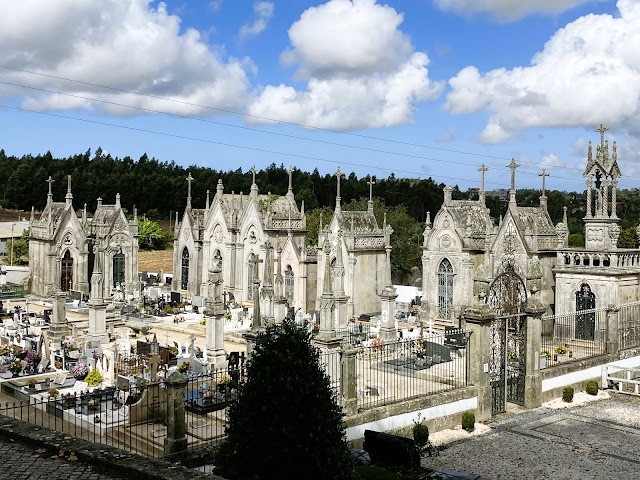





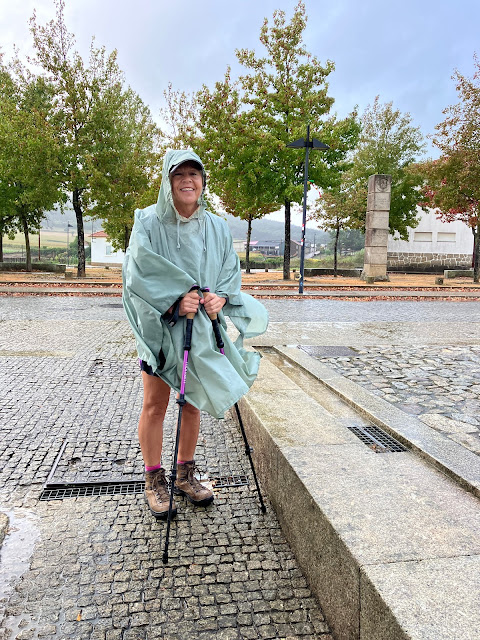











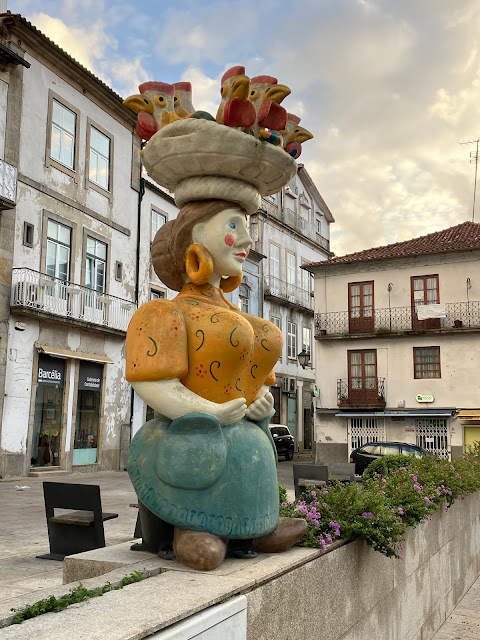


























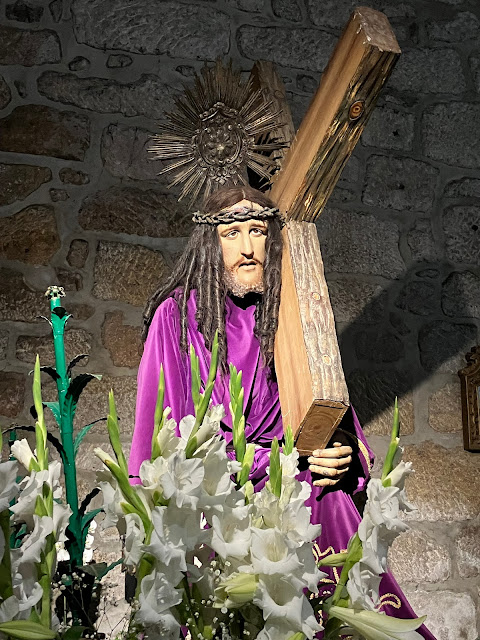
















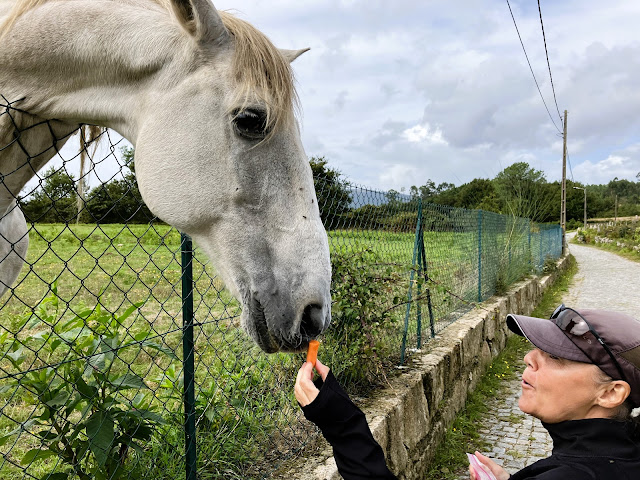








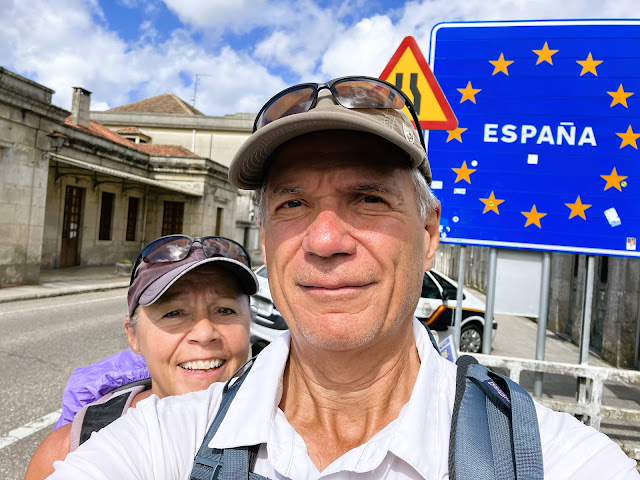
Comments
Post a Comment